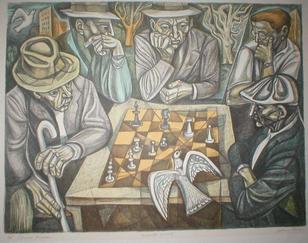Difference between revisions of "Moves"
GerdIsenberg (talk | contribs) m |
GerdIsenberg (talk | contribs) |
||
| Line 1: | Line 1: | ||
'''[[Main Page|Home]] * [[Chess]] * Moves''' | '''[[Main Page|Home]] * [[Chess]] * Moves''' | ||
| − | [[FILE:chessMove.JPG|border|right|thumb|308px|link=http://www.irvingamen.com/works/ChessMove.htm|[[ | + | [[FILE:chessMove.JPG|border|right|thumb|308px|link=http://www.irvingamen.com/works/ChessMove.htm|[[:Category:Irving Amen|Irving Amen]], Chess Move, 1977 <ref>[http://www.irvingamen.com/lithograph.htm Lithographs by Irving Amen]</ref> ]] |
In Chess terminology or [[Game Notation|game notation]], a '''Move''' (or full move) implies a [[Pieces|piece]] movement of both sides, white and black, e.g. 1. d4 Nf6. To relax this ambiguity, the term Half-move is used, also donated as one [[Ply|ply]], to make sure that it is only the piece movement of one single side. However, in the context of chess programming, if not stated otherwise, the term Move refers the piece movement of one side, thus a half-move. | In Chess terminology or [[Game Notation|game notation]], a '''Move''' (or full move) implies a [[Pieces|piece]] movement of both sides, white and black, e.g. 1. d4 Nf6. To relax this ambiguity, the term Half-move is used, also donated as one [[Ply|ply]], to make sure that it is only the piece movement of one single side. However, in the context of chess programming, if not stated otherwise, the term Move refers the piece movement of one side, thus a half-move. | ||
| Line 76: | Line 76: | ||
=External Links= | =External Links= | ||
* [http://www.gnu.org/software/xboard/Betza.html Betza notation and XBoard] » [[Chess#Variants|Chess Variants]], [[XBoard]] | * [http://www.gnu.org/software/xboard/Betza.html Betza notation and XBoard] » [[Chess#Variants|Chess Variants]], [[XBoard]] | ||
| − | * [[ | + | * [[:Category:NHOP|NHØP]] & [[:Category:Joe Pass|Joe Pass]] - Move, Jazzhus Slukefter, [https://en.wikipedia.org/wiki/Tivoli_Gardens Tivoli], [https://en.wikipedia.org/wiki/Copenhagen Copenhagen], 1982, [https://en.wikipedia.org/wiki/YouTube YouTube] Video |
: {{#evu:https://www.youtube.com/watch?v=ITlDupUbekc|alignment=left|valignment=top}} | : {{#evu:https://www.youtube.com/watch?v=ITlDupUbekc|alignment=left|valignment=top}} | ||
| Line 83: | Line 83: | ||
'''[[Chess|Up one Level]]''' | '''[[Chess|Up one Level]]''' | ||
| + | [[Category:Irving Amen]] | ||
| + | [[Category:NHOP]] | ||
| + | [[Category:Joe Pass]] | ||
Revision as of 14:12, 29 June 2018
In Chess terminology or game notation, a Move (or full move) implies a piece movement of both sides, white and black, e.g. 1. d4 Nf6. To relax this ambiguity, the term Half-move is used, also donated as one ply, to make sure that it is only the piece movement of one single side. However, in the context of chess programming, if not stated otherwise, the term Move refers the piece movement of one side, thus a half-move.
In the context of search, a Move is the edge, connecting two Nodes, which represent two consecutive chess positions inside one path of the search tree.
Contents
Type of Moves
Quiet Moves
Altering Material
- Captures
- En passant capture
- Promotions
- Piece Drop in various Chess variants
Tactical Properties
Reversibility
Involved Squares
Encoding and Generating
Notation
Adjunct Moves
Those moves are determined by search and are matter of move ordering:
- Best Move
- Hash Move
- Killer Move
- PV-Move
- Refutation Move
- Threat Move from null move refutations
Make and Unmake
See also
Publications
- Alex Bell, N. Jacobi (1979). How to read, make and store chess moves. The Computer Journal Vol. 22, No. 1, 71-75
- Barak Oshri, Nishith Khandwala (2015). Predicting Moves in Chess using Convolutional Neural Networks. pdf [2] » Deep Learning, Neural Networks
External Links
- Betza notation and XBoard » Chess Variants, XBoard
- NHØP & Joe Pass - Move, Jazzhus Slukefter, Tivoli, Copenhagen, 1982, YouTube Video
